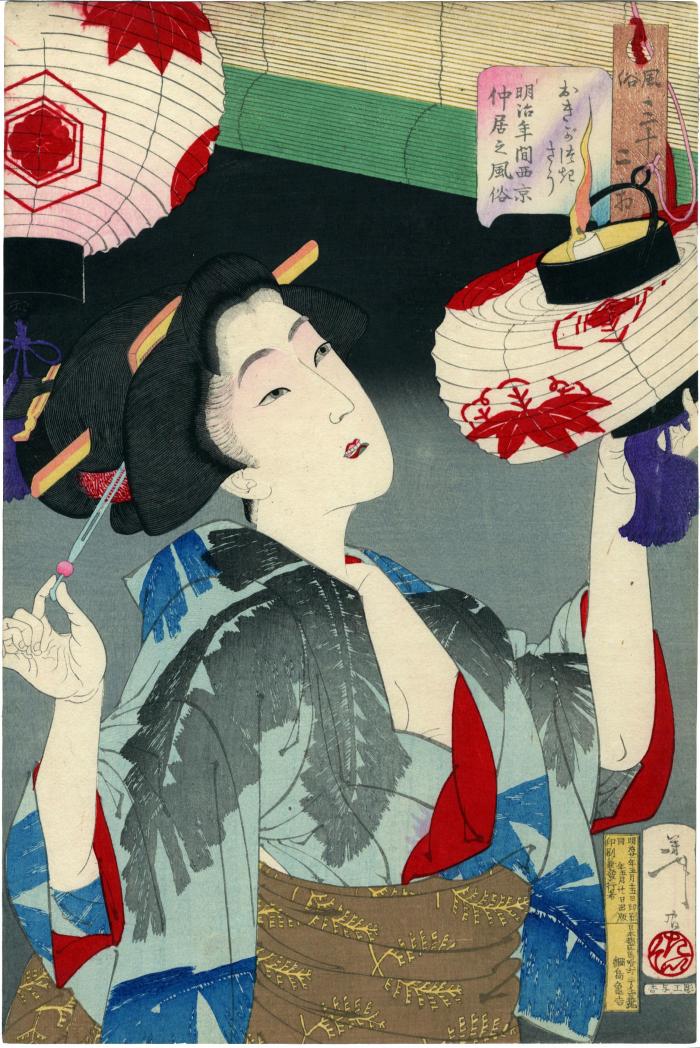Tsukioka Yoshitoshi (月岡芳年) (artist 04/30/1839 – 06/09/1892)
Looking Capable (Okigatsuki-sō - おきがつきさう): The Appearance of a Kyoto Waitress in the Meiji Era (Meiji nenkan saikyo nakai no fuzoku - 明治年間: 西京仲居之風俗) from the series 'Thirty-two Aspects of Customs and Manners' (Fūzoku sanjūni sō - 風俗三十二相)
1888
9.375 in x 14 in (Overall dimensions) Japanese woodblock print
Signed: Yoshitoshi ga
Artist's seal: Taiso
Publisher: Tsujiokaya Kamekichi (Tsunashima Kamekichi) Marks 549
Family name in kanji in the yellow inset
Carver: Horiko Yokichi (彫工与 吉)
Los Angeles County Museum of Art
National Diet Library
Hagi Uragami Museum of Art
The National Museum of Asian Art
Centre Céramique de Maastricht
Ritsumeikan University
Philadelphia Museum of Art
Museum of Oriental Art, Venice (via Ritsumeikan University)
Minneapolis Institute of Art
Lyon Collection - another print from this series: Looking Hot
Lyon Collection - another print from this series: Looking Feminine
Lyon Collection - another print from this series: Looking Tiresome "The nakai of the title means 'waitress,' but a special sort of waitress. This girl is the employee of a Kyoto geisha house, her function being that of a go-between. A nakai handled arrangements between customer and geisha, and the proprietor of the House [sic], customer and proprietor. She thus needed the special qualities that are summed up in the okigatsuki of the title, meaning 'capable,' 'observant,' 'able to hand many matters.' Yoshitoshi shows her busily occupied: she has noticed an untrimmed wick in one of the large collapsible paper lanterns of the establishment and is taking out her hairpin to attend to it. Her elaborate hairstyle is called sakikougai and was very popular among young ladies in western Japan in the first half of the nineteenth century. Preoccupied as she is with her responsibilities, her face has rather a hard expression.
It is summer, the bamboo blinds have been rolled up to let in the night air. Her half-open summer robe bears a large palm-leaf design. The engraving of the leaves has skillfully reproduced the artist's wide, brushstrokes with their ragged ends, and the printers have added their subtle gradations of shade....
The word saikyo, 'western capital,' is used in the title and refers to Kyoto (as opposed to the 'eastern capital,' Tokyo). People in the Kyoto-Osaka area had a reputation for being more thrifty and practical than Edoites in the east."
Quoted from: Yoshitoshi's Women: The Woodblock Print Series "Fuzoku Sanjiso" by John Stevenson, Avery Press, 1986, number 25, p. 78. Illustrated in a full-page color reproduction on page 79.
****
There are other copies of this print in the Worcester Museum of Art, the Chiba City Museum of Art and the Edo-Tokyo Museum.
beautiful woman picture (bijin-ga - 美人画) (genre)
Meiji era (明治時代: 1868-1912) (genre)
Tsujiokaya Kamekichi (辻岡屋亀吉) (publisher)
